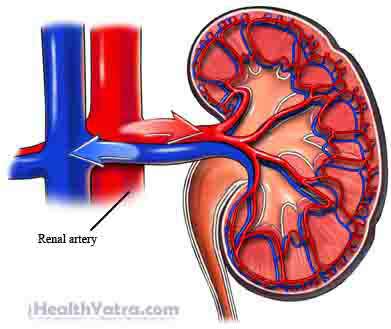تعريف
Renovascular hypertension is high blood pressure that is caused by narrowing (stenosis) of one or both of the arteries, called the renal arteries, that supply blood to the kidneys. Narrowing of the renal arteries reduces blood flow to the kidneys. This is a potentially serious condition that requires care from your doctor.
Each kidney is capable of regulating the body’s blood pressure to assure that each organ has an adequate supply of oxygenated blood. This happens by activating a cascade of hormones known as the renin-angiotensin system.
Renal artery stenosis triggers the release of these hormones, which then becomes a cause for hypertension (high blood pressure). Since hypertension is a leading cause ofstrokes and heart attacks, this is a serious condition that requires diagnosis and treatment.

أسباب
There are many diseases that can cause narrowing of the renal arteries. The two most common causes are atherosclerosis and fibromuscular dysplasia.
- Atherosclerosis—often called “hardening of the arteries,” results when fatty plaque builds up in the arteries and blocks blood flow to the kidneys. This occurs mainly in men over 50.
- Fibromuscular dysplasia—an inherited disorder where muscle and fibrous tissue of the renal artery wall thicken and harden into rings that block blood flow to the kidneys. This occurs mainly in young females in their 30s.
عوامل الخطر
A risk factor is something that increases your chance of getting a disease or condition. The following factors increase your chance of developing atherosclerosis or fibromuscular dysplasia, which are the leading causes of renovascular hypertension.
- التدخين
- السمنة
- سن متقدم
- عالي الدهون
- مرض السكري
- Personal or family history of cardiovascular disease
- Personal or family history of fibromuscular dysplasia
الأعراض
Because problems with the renal arteries develop slowly and worsen over time, and most people do not experience symptoms of high blood pressure, you may not notice any symptoms.
However, the following symptoms may be signs of renovascular hypertension. If you experience any one of them, talk to your doctor:
- Very high and difficult to control blood pressure
- A “whooshing” sound in the abdomen, heard with a stethoscope
- Episodes of heart failure
- Rapid kidney failure
- Newly discovered hypertension in men over 50 years old or young women in their 30s
التشخيص
Your doctor will ask about your symptoms and medical history, and perform a physical exam. You likely will be referred to a doctor who is a kidney specialist (nephrologist). Your doctor may take multiple blood pressure measurements over time and conduct blood tests to help diagnose your condition.
If you have renovascular hypertension, your doctor may conduct any of the following tests to see the amount of narrowing in the kidney arteries:
- Renal arteriography—a dye is injected into the kidney arteries and an x-ray is then taken of them
- Doppler ultrasound —a procedure that uses sound waves to examine various parts of the body
- Magnetic resonance angiography —a procedure that produces very detailed two- and three-dimensional images of the arteries by using radio waves in a strong magnetic field instead of using x-rays
- Angiotensin-converting enzyme (ACE) inhibition renography—a noninvasive imaging procedure that tests for the presence of renovascular hypertension and renal artery stenosis
- CT angiography—a procedure that uses high resolution CT scan images and contrast injected into a vein to give an accurate picture of the renal arteries. This procedure is rapidly replacing renal arteriography.
العلاج
التحدث مع طبيبك حول خطة العلاج الأفضل بالنسبة لك. خيارات العلاج ما يلي:
الأدوية
Your doctor will first prescribe medication to help control your blood pressure. Because responses to medications vary, your doctor will monitor your blood pressure frequently and may adjust the type, combination, and/or dose of medication. Types of high blood pressure medications (antihypertensives) include the following:
- Diuretics
- Beta-blockers
- Calcium channel blockers
- ACE inhibitors (except in those with both renal arteries blocked)
- Angiotensin receptor blockers
- Alpha-blockers
- Vasodilators
Interventions to Correct Renovascular Hypertension
If you have severe, uncontrolled renovascular hypertension, your physician may suggest interventions to restore blood flow to the kidneys. Types of interventions include the following:
- Revascularization—A vascular surgeon will perform a major operation, which creates a new path for blood flow to the kidneys by connecting one of your veins, or a tube, above and below the blocked area.
- رأب الأوعية الدموية —This is a less invasive method in which a catheter with a balloon at its tip is inserted into the blocked artery. The balloon is quickly inflated and deflated to stretch open the artery to allow blood flow. Your physician may insert a small metal mesh tube, called a stent, into the artery to help it stay open.
- استئصال باطنة الشريان —This is another type of major surgery in which there is removal of the inner-lining of the renal artery containing the plaque.
الوقاية
To help reduce your chances of getting renovascular hypertension, take the following steps:
- توقف عن التدخين.
- الحفاظ على وزن صحي.
- Maintain healthy cholesterol and lipid levels.
- اتمرن بانتظام.
- Eat a low-fat, low-protein, low-sodium, high-fiber diet.
